The 2018 SparkFun Customer Survey has come and gone. We'll be contacting the winner of the Taz Mini 3D Printer today; if you don't receive an email saying you are the winner by the end of today I am deeply sorry to tell you you have not won.
Now on to the data. I've selected a few questions to get some conversation started about SparkFun and the electronics/engineering worlds. I apologize for some of the weird text under the bar charts, but I'll take what Survey Monkey gives. Also note this data was not further broken down by any specific group that answered, all of this is just at the top level of responses. We're keeping the deeper dive for internal use. Here we go!
I've shared the very first actual question of the survey here. Given that about 9,000 people answered this question I'll take it as statistically significant. Actually, every question was answered to a statistically-significant level, which is awesome!
We see here that our main set of customers are overwhelmingly hobbyists and tinkerers. The next largest group are buying for some sort of work-related purpose. Rounding out the rest are educators, artists and students.
The fact that over 70 percent of customers are building projects for themselves is very interesting - as customer needs and desires shift, it's always cool to see that most people are really just solving a problem with a project they're making themselves.
Next, we see where people like to share their accomplishments. Almost 60 percent don't share at all; I suppose that 60 percent are non-millenials (joke). Of those who do share, most rely on their own website to share stuff. This tells me there are a lot of hardware/software makers out there who can not only build a cool hardware project, but also handle putting it on their own website!
Further down, Facebook dominates the social media world, which it does in general. Instructables is the highest-used maker-specific platform. The highest unlisted item under "other" was GitHub, which also makes a lot of sense. As a whole, I see a lot of people who take pride in their projects without sharing them, and another 40 percent that shares their work across a mixture of channels.
We were really wondering how involved our community is with makerspaces, so we asked! Nearly two-thirds responded that they don't use makerspaces at all - only 10 percent are very frequent users of makerspaces. Pete Dokter has a recent blog post about collaboration that addressed this, in a way. My guess is most people choose not to use them, while a much smaller percentage just don't have an accessible makerspace nearby. Since most of the respondents are hobbysists and use electronics for fun or as a side project, it makes sense that a lot of people may want to work alone. What are your thoughts on makerspaces and why you would or wouldn't be inclined to use them?
Next we have a SparkFun-specific question. The Dumpster Dive is a huge deal every time we do it. Based on the data, that appears to be driven by a very interested group of about 1000 people. I fear for the sanity of our kitting and shipping departments if an additional 4000+ want to participate. We'd manage, but I'm not sure there's enough reject boards to fill the demand; our production and QC departments are far too good to let that happen (wink). Jokes aside, that's a pretty high potential demand for random parts that may or may not be fully functional. One person's discarded circuit board is another person's potential project, as the colloquialism goes.
Now to some demographics. This graph isn't wholly surprising, but I hope it will continue to change over time. The world of engineering has been dominated by men for a long time, so this fits in line with that data. This isn't the easiest subject to approach, but I think it's important to call out that there's still a lot of work to be done by SparkFun and the entire electronics community. Are there any ways you would like to see us address this imbalance?
The last graph gives some insight on the education level of our customers. This makes a lot of sense to me, given that most skills needed to use electronics and programming have been taught in college up until now. SparkFun is part of a movement that hopes to move this stage of learning earlier and earlier into schools. Our technological future will ask a lot of future generations, and having good knowledge of electronics and programming at the high school and even middle school levels will really elevate student learning.
Right now it appears that four years or more of college is where the majority of our customers come from. Do you see fewer people needing higher-level education in the future to become electronic hobbyists, or will the lower barriers to entry available today make education level less significant in participating?
Thanks for taking a look at the data and weighing in! Obviously, data can be parsed, analyzed and reported on to come up with a bunch of different conclusions, but I thought it best to let you draw your own!
Thank you to everyone who participated, and let us know what you think can be done better or what's going well that you'd like to see more of. Have a great day!
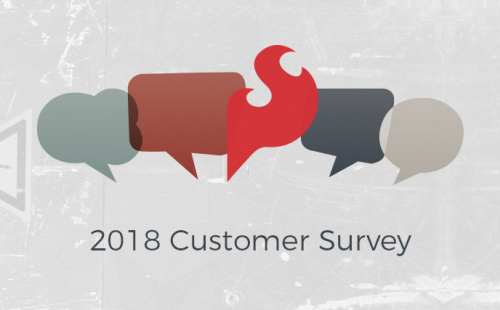
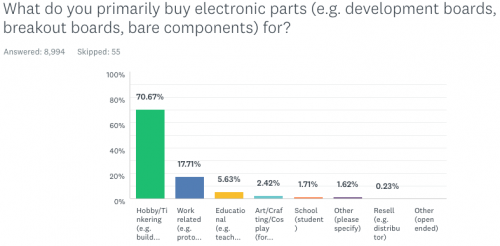

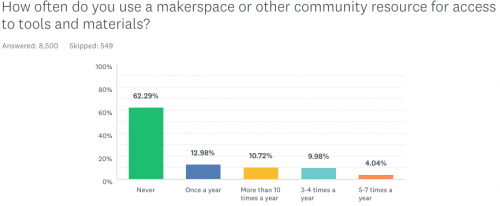
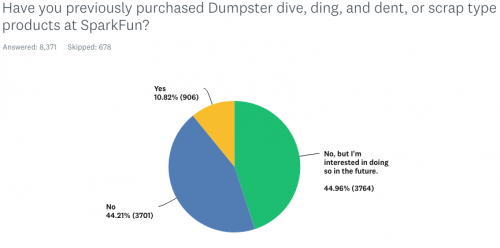
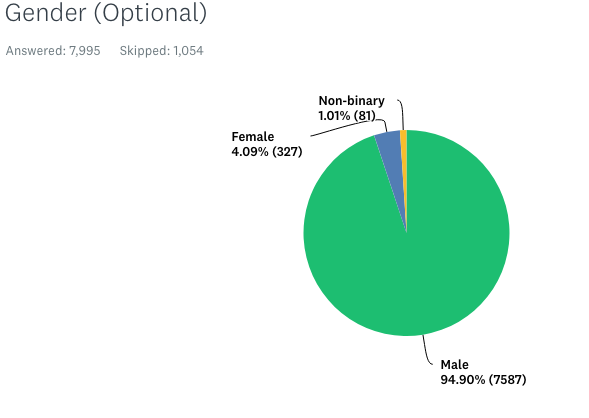







The education level distribution demonstrated in your survey results may not reflect the potential for success and enjoyment of this hobby. I am amazed to see how the kids keep knocking things out of the park. So please, keep up your efforts towards knocking those barriers down!
With regard to "Makerspace", the "anti-social geek" stereotype fits me well. I would much rather interact with people remotely than face-to-face.
Cheers,
Mark
For the makerspace question.. The biggest reason I don't frequent my local makerspace (only 1 space around; North San Diego County) is due to cost of membership along with hours of operation. Spending $150 a month for something only open in afternoons and weekends is hard when you have a family and your main time to do anything is between 8pm and 9pm. Plus $150 a month goes a long way for projects or new tools.
Seconded. The makerspaces in my area aren't nearly that expensive, but I haven't found one that fits in my hobby budget with any room left over for actual hobbying. No point in having access to all the tools if I can't afford the materials.
Based on my experience, I think most people don't have access to a reasonably accessible makerspace that is properly equipped.
All the places I've lived have been university towns, which I'd expect to have a prime demographic for makerspaces, however only the city I current city I live in has a makerspace... and it has issues.
The makerspace is owned and operated by the university which causes a few problems, most of which I won't get in to. It was founded by a woodworking group, and it shows; they have some high end woodworking equipment but the other areas are mostly donated equipment and are quite lacking. A lot of people who shop at sparkfun probably have better equipped electronics benches than the makerspace does (more on that later). To be fair you might suggest they are just starting out and are still building up, however in the tour I took a year and a half ago they had no metalworking and claimed they'd be setting it up in the following year. According to their website none of that has been added, so they aren't really expanding/improving at all.
And then there is price... A one year membership is $660. Not only is that more expensive than I'd consider reasonable for a weekend hobbyist, but the cost of a one year membership is enough to fully equip your own workbench with better equipment than they provide AND have money left over for random components to play with.
I know I'm ranting a bit, and I don't mean to be tearing apart the local makerspace. My point is that from what I've seen it's not that people don't want to visit a makerspace, but that I think most people don't have a makerspace near them worth going to.
It would be interesting to see a breakdown of WHY that 62% don't visit makerspaces. The article guesses that a majority simply don't want to, but I tend to think more along Drakonite's line of thinking that they just aren't available, aren't suitable, or are too expensive.
I've looked at The Maker Map and it actually shows that there are four listings that are within a couple hours drive of me. But when looking at the details: * One is an electronics component retailer * One is a woodworking veneer retailer * One seems promising, but costs $600 a year, and the website offers no information on what they actually offer * One sounds absolutely fantastic and just what I would be looking for, but it is mis-placed on the map: it's actually about 2000 miles away in California.
As Drakonite put forth, I probably have a better electronics workbench at home than many makerspaces, and access to an even better one at work. My main interest is occasional access to a laser cutter, and for $600 a year, I can send a lot of jobs out to Ponoko and still be ahead of the game.
So, I contend that the reason I don't go to a makerspace is because one is not available at a reasonable price. But after writing the previous paragraph, maybe it will be interpreted that I simply don't want to go to one? An interesting dichotomy... But I still contend it's availability: if there was one with the equipment I needed, and available at a reasonable "pay as you go" basis as opposed to a long term "whether you use it or not" expensive membership, I would be all over it.
As a card-carrying old fart, I resemble that comment! ;)
I got the joke right away. And as proof of my non-millenial status, I offer that I had to google ELI5 to figure out what rsp was saying...
I don't share partly because of my long term background doing defense development, and proprietary commercial development (you certainly don't share details of either!) and partly because I have no interest or time for social media sites like Facebook, Twitter, or the numerous other similar venues. I do try to help others on a few various forums, but I don't generally post my projects there (often because they are specific to my needs, and probably not generally interesting.)
Millennials tend to get stereotyped as sharing everything they do, especially on social media.
On Makerspaces: Like the majority here, I don't use any Makerspaces. As has been implied, I have better equipment at home, that I'm used to, that hasn't been mucked with since the last time I left the bench. If I only have an hour or so a night, and then have to come back, a shared Makerspace isn't going to remain undisturbed 'til the next visit. And no, packing my project, mid-assembly into a project box to carry home and back, isn't my idea of fun either. When I have gone to Makerspaces (or events) I find I'm not learning as much as sharing what I know, hence if I'm focused on a project (of my own) it is less conducive / productive in a shared environment. And along the millennial joke line here, I can't concentrate on nitty-gritty details in a noisy environment like so many younger folks seem to be able to do these days.
On Sharing: So many projects are so narrow in focus, that other than sharing code on GitHub, or similar, a lot of projects just don't seem to have overlap enough to share. I do a lot with stepper motors, and each project seems very unique. So sharing happens more on narrowly focused forums than in wide open public spaces, so to speak.
On Gender: Engineers and programmers are generally "problem solvers." Give them a problem and they go tackle it. But in order to attract youth and cross gender boundaries, it is more important to find things that generate interest, and the interest grows into a desire to do the next thing. Learn more, do more, step-by-step. A good example is the number of females that got hooked on fashion-extending sew-in boards (think LilyPad and about that other company that makes a lot of blue PCB's). While that's not my interest, it certainly crosses the gender boundaries more successfully than yet another 9 DOF sensor, or parts for more BattleBots / Killer Robots (I think I can safely say those generally attract males ;-).
Asking people about their ages and what they studied in school/college would be interesting. Jameco's similar survey a few years indicated that almost all their hobbyists were retirement age.
As for Makerspaces, I agree that cost and accessibility are the main barriers for me. The closest makerspace is close enough, but too expensive ($45/month to get access to hand tools no better than I have at home, $90 a month to get 4 hours/week of reservable time on the good tools (laser cutter, 3D printer), $120 a month to get 8 hours/week (adding the Shopbot to the allowed tools), $240 a month to get 12 hours/week). If I had a project that actually used that much of the equipment time, the prices would be good (under $6 an hour), but I tend to have no time for most of the year, then I want a chunk of equipment time all at once, so the hours/week subscription model doesn't make much sense for me.
The local community college has a makerspace that is $145/month ($105/month if you take two of their training courses). There is $20 worth of materials included in that fee. It is a 50-minute bike ride away, so I would be hard pressed to go there often, and only 4 hours a month of laser time and 10 hours a month of 3D printer time are guaranteed in the membership.
Although I would probably like the camaraderie of a makerspace, I have a hard time justifying the expense, which would buy me a lot of tools and parts that I could use without reserving them a week in advance.
I would be interested in the age distribution. I am well into the senior citizen range, I wonder how many more are?
As to sharing, my issues is I have no one to share with. I am retired and live in a rather rural place- lots of people to talk to about boats and golf, but I bet there is not another tinkerer in miles. I do post some work on my personal web page- pleasantcovemodels.com but its mostly the machining part, not electronics.
Im thinking about a project to monitor data from my boat engine which I would love to sit down and talk to someone about. I dont have a specific question to post, I just want to throw around ideas and see what comes to the top.
Hi Ron, i understand your idea to have someone to talk to - just in an relaxed way - throw around ideas and so on..
i have lived in different cities and visited about 4 different (also in type) *spaces (fablabs, makerspaces, hackerspaces, and other communities) and till now only found one person where i have the feeling of 'someone' with whom i just can chat around and talk and think about ideas - i no longer life in the near - so we do this sometimes via chat.. but its not the same... one place to get toghether is events like MakerFaire and similar... i think its a good place to just meet other people... - they are eventually from the other side of the world - but hey - sometimes the can come from the same town or so too ;-) - thats the way i try to do currently - go to different events and meet people - get out there so i have the chance to make new friendships .-) :-)
About 5% listed themselves as 70+, just to answer your question. Most are middle-aged.
I live in Philly, PA and the hackerspace (hive76) moved further away, so it's no longer practical for me to go there routinely. As for gender divide, I think it's a matter of time. There are a lot of females showing, for example, RPi projects and making great videos, so that momentum needs to keep going.
I think it would be very interesting to further elaborate on the educational background, beyond just degree level. Since this survey is largely of hobbyists, I'm curious how many actually have engineering/science/computer backgrounds/degrees and how many don't. I've got a BA and a JD, no engineering degree here. I'm a hobbyist because I'm learning all this as I go and I don't have to worry about electronics and such in my day job.
Good question! We only asked the job title question of those who responded that their main use of electronics parts is work-related. Top answers were a range of electrical, design, and software engineers along with words like research, technician, and development. That doesn't really answer your question, but my guess is the hobbyists segment much more diverse, but has a lot of similar professions.